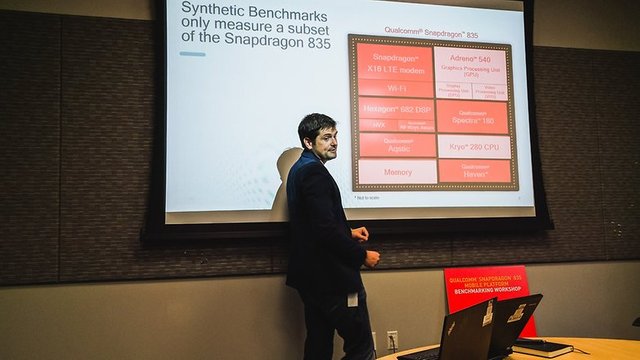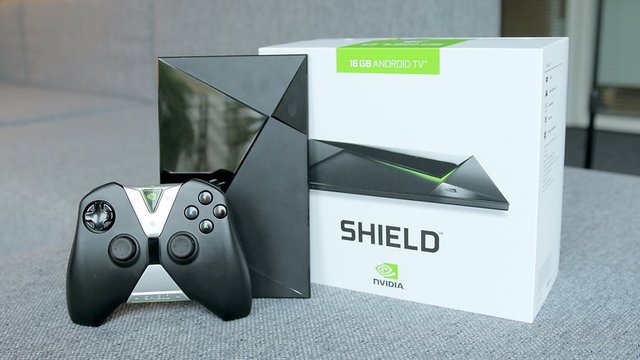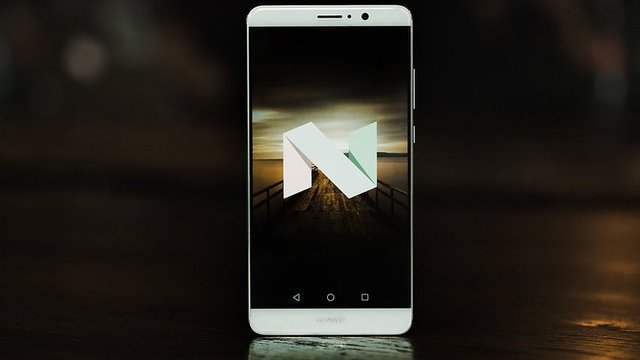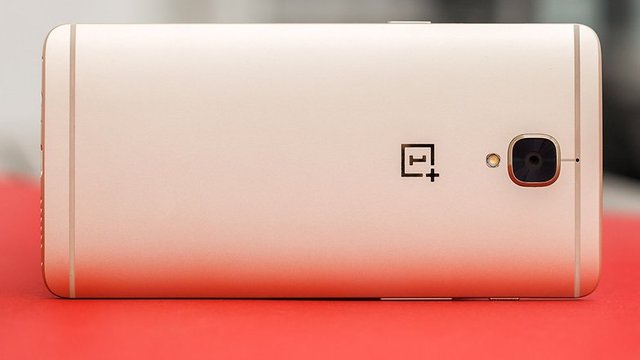THE BEST SMARTPHONE PROCESSORS: A COMPARISON
The processor is the core component of a smartphone, which helps determine the operating speed. Therefore, it is crucial that it operates at a fast speed. But what makes one cellphone processor faster than the others? The clock rate and the number of cores do not tell the whole story. There’s more to these chips than what the meager data sheets in cell phone stores reveal. Thus, they are called system-on-a-chip, or SoC, for short.
Ideally, a SoC consists of a central processing unit (CPU), graphics processing unit (GPU), modem, multimedia processor, security device and signal processor. This multitude of features makes it difficult to declare one particular cell phone processor as the fastest.

AndroidPIT qualcomm snapdragon 835 benchmark event 090049
Qualcomm Product Manager Travis Lanier explains the Snapdragon 835. / © AndroidPIT
Benchmarks only cover a few of a processor’s performance areas. This overview allows us to provide results for operating speed and gaming speed. Unfortunately, we do not yet have the ability to measure energy consumption and antenna performance.
The ARM CPU: The common denominator of smartphone processors?
Nearly all smartphone chips use the ARM architecture for their CPU. ARM provides CPU classes of varying performance levels, which are found in several variations in smartphone SoCs. The trick lies in the chips’ composition and clock rate.
The Samsung Galaxy S4 was one of the first to implement ARM’s big.LITTLE design principle, which is the pairing of two different processor clusters in one housing. The big cluster contains up to four high-performance CPU cores and the LITTLE cluster has up to four CPU cores that are tuned for energy efficiency.
But this exact architecture will be scrapped in the next ARM generation, making more sizes and clock speeds common in a single SoC.
The graphics unit: are there any big differences when gaming?<\h1>Chip manufacturer Nvidia integrates a strong graphics processing unit (GPU) for smartphones and tablets in its Tegra X1. The number of games that can take advantage of it is increasingly growing. Nvidia has a list of Play Store titles that support the Nvidia GPU.

nvidia shield package
Nvidia has the fastest mobile GPU, which helps some games achieve truly excellent graphics. / © ANDROIDPIT
However, Qualcomm has upped the ante with the Snapdragon 835 and, particularly, its integrated Adreno 540 GPU, which impresses in all tests. Thanks to its support for DirectX 12, Qualcomm even wants to enter the Windows laptop market with it in 2017.

AndroidPIT qualcomm snapdragon 835 benchmark event 144717
DX12, Tessellation, VR, AR: Qualcomm’s Adreno can hold its own. / © AndroidPIT
You can feel the difference between slow and fast GPUs in Android when you run a new game with a really old smartphone. Unlike on a Windows computer, the games do not lag (for the most part). Instead, they lower the level of detail.


real racing graphic details difference
Real Racing 3 only shows details such as mirroring and instrument lighting with a fast processor. In the top picture, the game was run on an Exynos 7420 on a Galaxy S6 Edge, and in the bottom picture, on a Snapdragon 400 in the Moto G (2013). / © ANDROIDPIT
AndroidPIT Google Pixel C 8784
The Google Pixel C tablet achieved over 40,000 points in Basemark X. / © ANDROIDPIT
The fastest mobile GPU in a portable Android device is still in the Google’s Pixel C tablet. The three processors that are used in Android smartphones are just about dead even. Huawei has done an excellent job optimizing the Kirin 960 in the Mate 9, and it could hold its own. However, smartphones with the Snapdragon 835 will be able to take it a step further.

AndroidPIT huawei mate9 0158
Nougat with Vulkan and Daydream support give the Mate 9 gaming power. / © AndroidPIT
There are great playmates in all sizes and form factors. If you wish to spend less money, you can simply opt for a OnePlus 3T. It has the Pixel’s Snapdragon 821 processor and offers just as good gaming performance.
Opinion by Eric Ferrari-Herrmann
Gaming performance is important to me.
What do you think?
5050
180 participants
The best processors: benchmark comparisons
Here we will take a look at the results of CPU and GPU tests and inform you which Android devices have the fastest, best processors. For reference, we use mobile processors that are available in devices currently sold as of this article’s publication date.
Benchmark Values: Processing Power Index
PROCESSOR SNAPDRAGON 835 KIRIN 960 EXYNOS 8890 SNAPDRAGON 821 TEGRA X1
TEST DEVICE Qualcomm Reference Device Huawei Mate 9 Samsung Galaxy S7 Edge Google Pixel Pixel C Tablet
PROCESSING POWER INDEX 105.1% 100% (reference) 80.8% 75.5% 71.0%
The processing power index is composed of the results of Geekbench, PC Mark Work, and Octane.
Benchmark Values: Gaming Index
PROCESSOR SNAPDRAGON 835 TEGRA X1 KIRIN 960 SNAPDRAGON 821 EXYNOS 8890
TEST DEVICE Qualcomm Reference Device Pixel C Tablet Huawei Mate 9 Google Pixel Samsung Galaxy S7 Edge
PROCESSING POWER INDEX 117.3% 100% (reference) 88.0% 85.3% 84.2%
The gaming index is composed of the 3D mark tests Sling Shot Extreme (ES 3.1) and Ice Storm Unlimited (ES 2.0).
All about the best processors
Qualcomm Snapdragon 835
Samsung Exynos 8895
Huawei/HiSilicon Kirin 960
The Snapdragon 835 is the best processor, at least according to our benchmark results listed above. Qualcomm returns to the octa-core design with its latest offshoot, but it has mainly improved the GPU. Gamers in particular should look into smartphones with this processor, since this leap from the Snapdragon 821 will be particularly obvious in VR applications. Not only will content be rendered more quickly, but power consumption will be reduced by a third.

Snapdragon 835 benchmark: Qualcomm prepares itself for demanding VR gaming
AndroidPIT qualcomm snapdragon 835 benchmark event 141720
The Snapdragon 835 will be fun in VR applications. / © AndroidPIT
Apart from VR, the Snapdragon 820 and its improved variant, the 821, are still fast SoCs despite only having four cores. Thanks to the efficient Hexagon signal processors and optimizations for machine learning algorithms, they master virtually all of their successor’s tricks.
AndroidPIT Google Pixel Event2016 9894
Invisibly optimizing pictures: The Snapdragon 821 in the Pixel. / © ANDROIDPIT
The Google Pixel is one of the first devices that heavily uses the new features. In benchmarks, the chip does not provide great surprises. Rather, its talent is spread across day-to-day tasks, such as photography.
Samsung Exynos 8895
The Galaxy S8’s processor in the US is the Snapdragon 835, but elsewhere it's the Samsung Exynos 8895 and it introduces the Exynos 9 series. Here, too, is significantly increased gaming performance a topic of discussion. Samsung’s latest development clearly focuses on increased VR performance, since it requires higher screen resolutions.
The Galaxy S7’s Exynos 8890 marks the second time in a row that Samsung has managed to produce the fastest cell phone processor. But the SoC alone is not responsible for the Galaxy smartphones’ snappy feel.
Only when coupled with Samsung’s proprietary UFS 2.0 flash memory type do apps load quickly. Samsung also sells the memory to other smartphone manufacturers. As a result, they can be found in the OnePlus 3T, the Google Pixel, or in the Huawei Mate 9 - in every important competitor.

AndroidPIT OnePlus3 soft gold 6527
OnePlus uses quick Samsung memory. / © AndroidPIT
Huawei/HiSilicon Kirin 960
HiSilicon is an interesting competitor for Qualcomm and Samsung. Currently used exclusively in its own brands Huawei and Honor, it impresses in many areas. Voice quality is increased thanks to good sound processing. When it comes to LTE and Wi-Fi performance, the Chinese manufacturer demonstrates its strengths as a technology supplier. Even its graphics performance has caught up to the Galaxy S7 for the first time, thanks to the Vulkan API in the Mate 9 and a collaboration with ARM.
The best processors: conclusion
The highest scoring in our benchmark tests was the Snapdragon 835, which will be important for VR gaming. Furthermore, it shows that the market is saturated. Most processors from 2016 will also be fast enough in 2017. But as already mentioned at the beginning, the chip alone is not responsible for a high operating speed.
A stable mobile data connection and fast, tidy flash memory are at least just as important. The flagship devices of nearly every manufacturer now use fast UFS 2.0 flash memory from Samsung. Clear-cut, optimized software takes care of the rest, and Huawei seems to have developed a satisfactory solution here.